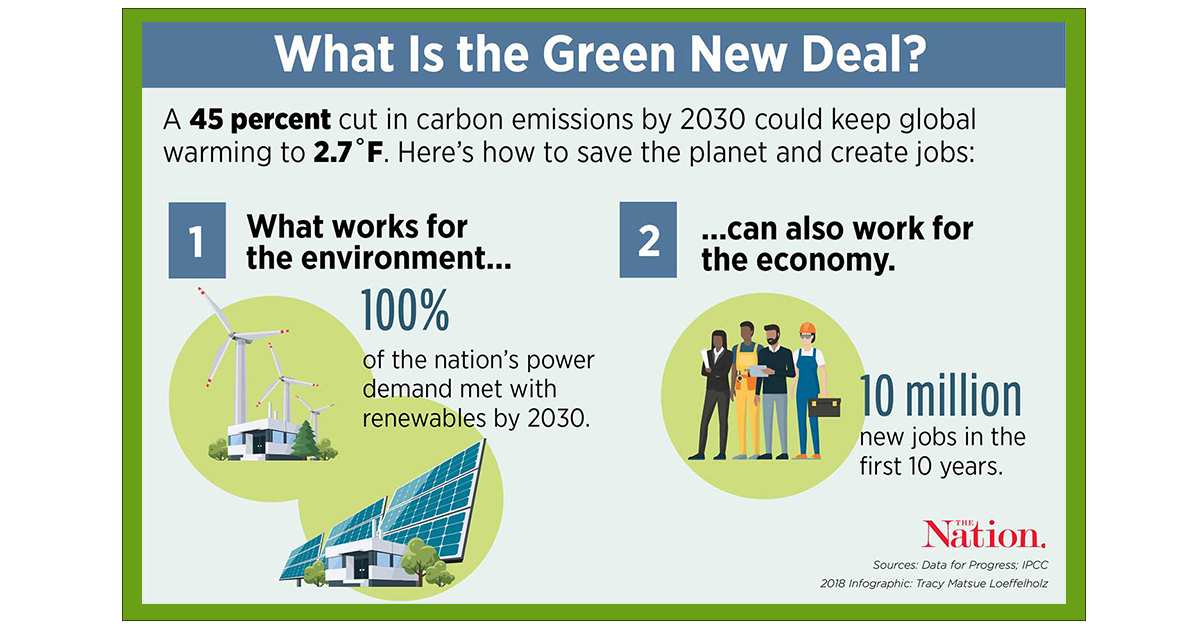No products in the cart.
What is the Green New Deal?
A term that’s purposefully reminiscent of President Franklin D. Roosevelt’s original New Deal in the 1930s, the Green New Deal is a concept that encourages bold and swift action on climate change, while simultaneously reducing unemployment and under-employment.

This phrase has been gaining momentum across news outlets and social media since the 2018 midterm elections. At first glance, most voters say they support the Green New Deal, but few actually know what it is.
Now is the time to become familiar with the Green New Deal proposal and its motivations. We plan to publish a few follow-up articles on this topic, so check back with us as we:
- track the story in the coming weeks
- highlight key players
- share persuasive quotes
- revisit historical milestones that led us here
- and more!
The goals of the Green New Deal include:
- meeting 100% of national power demand through renewable sources;
- building a national, energy-efficient, “smart” grid;
- upgrading ALL buildings for energy efficiency, comfort and safety;
- eliminating greenhouse gas emissions;
- repairing and improving transportation and other infrastructure;
- upgrading water infrastructure to ensure universal access to clean water;
- funding massive investment in the drawdown of greenhouse gases;
- making “green” technology, industry, expertise, products and services a major export of the United States, with the aim of becoming the undisputed international leader in helping other countries transition to completely greenhouse gas neutral economies and bringing about a global Green New Deal.
Leading scientists say we have 12 years to radically transform our economy and society to avoid climate disaster, and the Green New Deal aims to shift climate change discussions from that of research and recommendation to action and implementation.
The social and economic outcomes of the Green New Deal include:
- providing all members of our society the opportunity to be a full and equal participant in the transition, through a job guarantee program that assures a living wage job to every person who wants one;
- diversifying local and regional economies, with a particular focus on workforce retraining for displaced fossil fuel workers, to ensure they have the necessary tools, opportunities, and economic assistance to succeed during the energy transition;
- requiring strong enforcement of labor, workplace safety, and wage standards that recognize the rights of workers to organize and unionize free of coercion, intimidation, and harassment, and creation of meaningful, quality, career employment;
- ensuring that local implementation s led at the community level;
- protecting & enforcing sovereignty and land rights of tribal nations;
- including additional measures such as basic income programs, universal health care programs and any others as the select committee may deem appropriate to promote economic security, labor market flexibility, and entrepreneurism
How soon until the Green New Deal becomes law?
The Green New Deal isn’t just one law; it’s an overarching approach to climate change and economic equality that could result in several pieces of legislation.
A current draft of the Green New Deal calls for the completion of its goals within a target window of 10 years from the start of the plan.
To get things in motion, legislators have proposed the following:
- Jan. 2019 – The creation of a bipartisan select committee
- Jan. 2020 – Deadline for the select committee’s overall game plan
- March 2020 – Deadline for the select committee’s implementation plan
- Jan. 2021 – Time to enact the legislation
However, political infighting about the aggressiveness of this approach has led to recent conversations and decisions that will likely soften the strategy, such as not giving the committee any subpoena power.
Without subpoena authority, the panel’s main responsibility would be to hold hearings and write reports, which harkens back to climate committees from 10 years ago. It’s definitely a softened approach…if not the antithesis of what the Green New Deal aimed to do, with its focus on bold action and swift implementation.
The structure of the committee, including its powers and authorities, will be voted on by the House after the Democrats take power on Jan. 3, 2019.
For more information about the Green New Deal, check out these links:
The Green New Deal, Explained from Vox
Lots of People Support the ‘Green New Deal.’ So What Is It? from The Washington Post
Green New Deal from Wikipedia